Analysis of External Influences on Health and Social Care Services
VerifiedAdded on 2020/02/12
|8
|2495
|290
Report
AI Summary
This report examines the multifaceted influences on health and social care organizations. It begins by analyzing the impact of external environmental factors, such as political, economic, social, technological, legal, and environmental considerations, on organizations like the Voluntary Service Organisation (VSO). The report then evaluates how these organizations respond to these factors and their stakeholders. It further compares and contrasts different organizational structures, explores the concept of organizational culture, and analyzes theories of individual and group behavior within health and social care settings. The report also explains how organizational structure and culture impact service delivery, emphasizing the role of leadership in shaping organizational culture and ensuring effective service provision. The conclusion summarizes the key findings, highlighting the importance of adapting to external influences and fostering a culture that prioritizes quality service, patient well-being, and effective leadership.
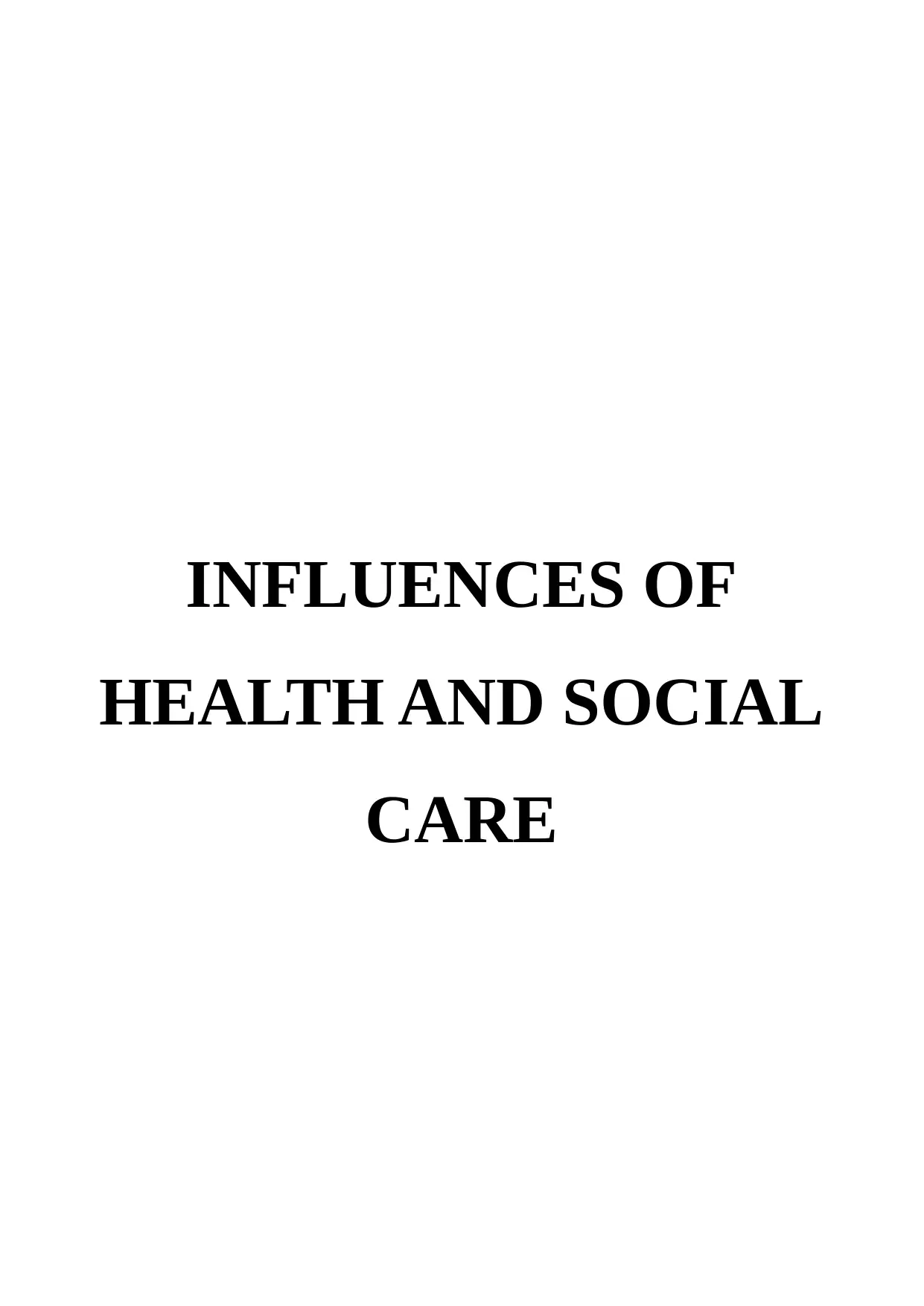
INFLUENCES OF
HEALTH AND SOCIAL
CARE
HEALTH AND SOCIAL
CARE
Paraphrase This Document
Need a fresh take? Get an instant paraphrase of this document with our AI Paraphraser
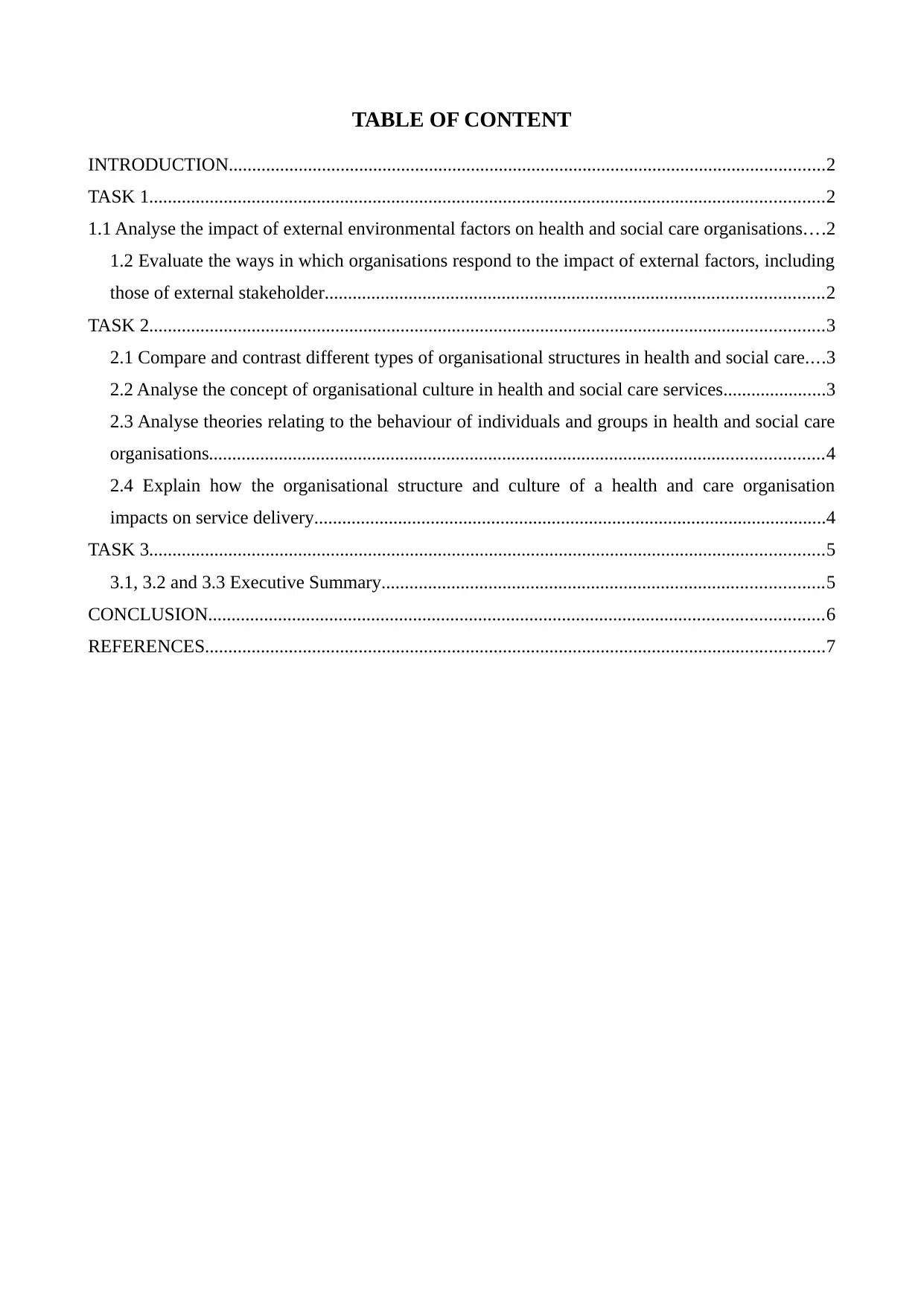
TABLE OF CONTENT
INTRODUCTION................................................................................................................................2
TASK 1.................................................................................................................................................2
1.1 Analyse the impact of external environmental factors on health and social care organisations....2
1.2 Evaluate the ways in which organisations respond to the impact of external factors, including
those of external stakeholder...........................................................................................................2
TASK 2.................................................................................................................................................3
2.1 Compare and contrast different types of organisational structures in health and social care....3
2.2 Analyse the concept of organisational culture in health and social care services......................3
2.3 Analyse theories relating to the behaviour of individuals and groups in health and social care
organisations....................................................................................................................................4
2.4 Explain how the organisational structure and culture of a health and care organisation
impacts on service delivery..............................................................................................................4
TASK 3.................................................................................................................................................5
3.1, 3.2 and 3.3 Executive Summary...............................................................................................5
CONCLUSION....................................................................................................................................6
REFERENCES.....................................................................................................................................7
INTRODUCTION................................................................................................................................2
TASK 1.................................................................................................................................................2
1.1 Analyse the impact of external environmental factors on health and social care organisations....2
1.2 Evaluate the ways in which organisations respond to the impact of external factors, including
those of external stakeholder...........................................................................................................2
TASK 2.................................................................................................................................................3
2.1 Compare and contrast different types of organisational structures in health and social care....3
2.2 Analyse the concept of organisational culture in health and social care services......................3
2.3 Analyse theories relating to the behaviour of individuals and groups in health and social care
organisations....................................................................................................................................4
2.4 Explain how the organisational structure and culture of a health and care organisation
impacts on service delivery..............................................................................................................4
TASK 3.................................................................................................................................................5
3.1, 3.2 and 3.3 Executive Summary...............................................................................................5
CONCLUSION....................................................................................................................................6
REFERENCES.....................................................................................................................................7
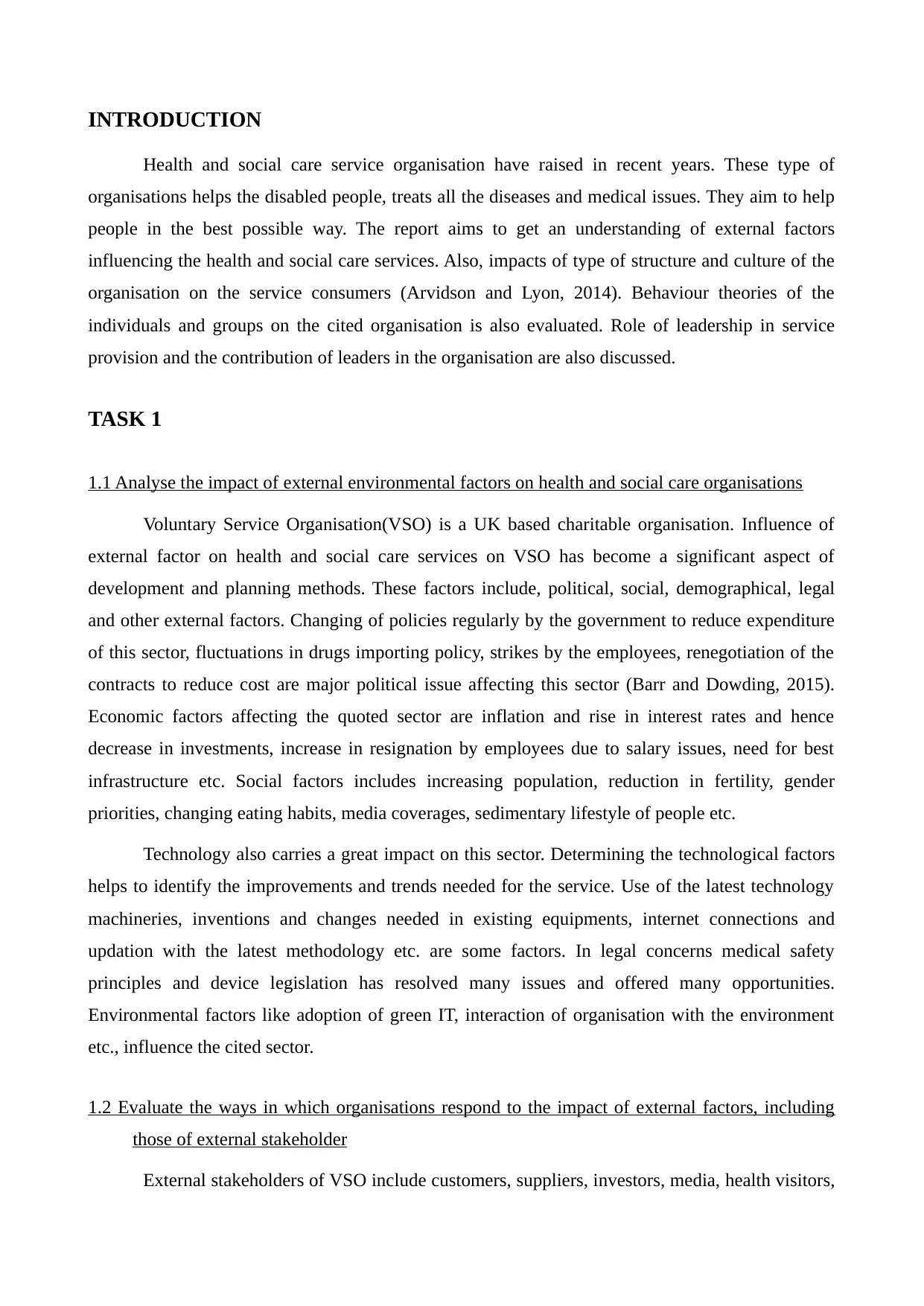
INTRODUCTION
Health and social care service organisation have raised in recent years. These type of
organisations helps the disabled people, treats all the diseases and medical issues. They aim to help
people in the best possible way. The report aims to get an understanding of external factors
influencing the health and social care services. Also, impacts of type of structure and culture of the
organisation on the service consumers (Arvidson and Lyon, 2014). Behaviour theories of the
individuals and groups on the cited organisation is also evaluated. Role of leadership in service
provision and the contribution of leaders in the organisation are also discussed.
TASK 1
1.1 Analyse the impact of external environmental factors on health and social care organisations
Voluntary Service Organisation(VSO) is a UK based charitable organisation. Influence of
external factor on health and social care services on VSO has become a significant aspect of
development and planning methods. These factors include, political, social, demographical, legal
and other external factors. Changing of policies regularly by the government to reduce expenditure
of this sector, fluctuations in drugs importing policy, strikes by the employees, renegotiation of the
contracts to reduce cost are major political issue affecting this sector (Barr and Dowding, 2015).
Economic factors affecting the quoted sector are inflation and rise in interest rates and hence
decrease in investments, increase in resignation by employees due to salary issues, need for best
infrastructure etc. Social factors includes increasing population, reduction in fertility, gender
priorities, changing eating habits, media coverages, sedimentary lifestyle of people etc.
Technology also carries a great impact on this sector. Determining the technological factors
helps to identify the improvements and trends needed for the service. Use of the latest technology
machineries, inventions and changes needed in existing equipments, internet connections and
updation with the latest methodology etc. are some factors. In legal concerns medical safety
principles and device legislation has resolved many issues and offered many opportunities.
Environmental factors like adoption of green IT, interaction of organisation with the environment
etc., influence the cited sector.
1.2 Evaluate the ways in which organisations respond to the impact of external factors, including
those of external stakeholder
External stakeholders of VSO include customers, suppliers, investors, media, health visitors,
Health and social care service organisation have raised in recent years. These type of
organisations helps the disabled people, treats all the diseases and medical issues. They aim to help
people in the best possible way. The report aims to get an understanding of external factors
influencing the health and social care services. Also, impacts of type of structure and culture of the
organisation on the service consumers (Arvidson and Lyon, 2014). Behaviour theories of the
individuals and groups on the cited organisation is also evaluated. Role of leadership in service
provision and the contribution of leaders in the organisation are also discussed.
TASK 1
1.1 Analyse the impact of external environmental factors on health and social care organisations
Voluntary Service Organisation(VSO) is a UK based charitable organisation. Influence of
external factor on health and social care services on VSO has become a significant aspect of
development and planning methods. These factors include, political, social, demographical, legal
and other external factors. Changing of policies regularly by the government to reduce expenditure
of this sector, fluctuations in drugs importing policy, strikes by the employees, renegotiation of the
contracts to reduce cost are major political issue affecting this sector (Barr and Dowding, 2015).
Economic factors affecting the quoted sector are inflation and rise in interest rates and hence
decrease in investments, increase in resignation by employees due to salary issues, need for best
infrastructure etc. Social factors includes increasing population, reduction in fertility, gender
priorities, changing eating habits, media coverages, sedimentary lifestyle of people etc.
Technology also carries a great impact on this sector. Determining the technological factors
helps to identify the improvements and trends needed for the service. Use of the latest technology
machineries, inventions and changes needed in existing equipments, internet connections and
updation with the latest methodology etc. are some factors. In legal concerns medical safety
principles and device legislation has resolved many issues and offered many opportunities.
Environmental factors like adoption of green IT, interaction of organisation with the environment
etc., influence the cited sector.
1.2 Evaluate the ways in which organisations respond to the impact of external factors, including
those of external stakeholder
External stakeholders of VSO include customers, suppliers, investors, media, health visitors,
⊘ This is a preview!⊘
Do you want full access?
Subscribe today to unlock all pages.

Trusted by 1+ million students worldwide
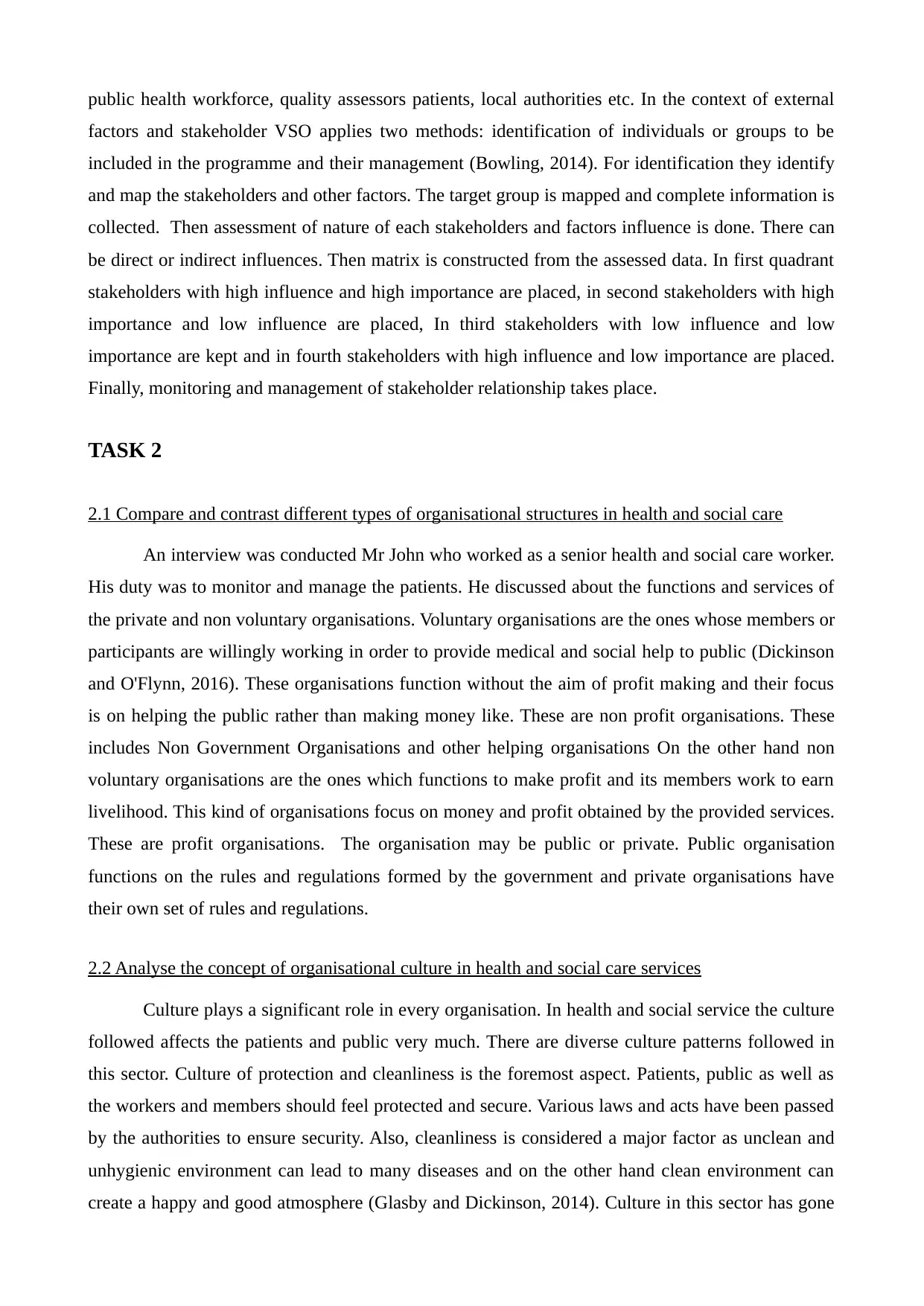
public health workforce, quality assessors patients, local authorities etc. In the context of external
factors and stakeholder VSO applies two methods: identification of individuals or groups to be
included in the programme and their management (Bowling, 2014). For identification they identify
and map the stakeholders and other factors. The target group is mapped and complete information is
collected. Then assessment of nature of each stakeholders and factors influence is done. There can
be direct or indirect influences. Then matrix is constructed from the assessed data. In first quadrant
stakeholders with high influence and high importance are placed, in second stakeholders with high
importance and low influence are placed, In third stakeholders with low influence and low
importance are kept and in fourth stakeholders with high influence and low importance are placed.
Finally, monitoring and management of stakeholder relationship takes place.
TASK 2
2.1 Compare and contrast different types of organisational structures in health and social care
An interview was conducted Mr John who worked as a senior health and social care worker.
His duty was to monitor and manage the patients. He discussed about the functions and services of
the private and non voluntary organisations. Voluntary organisations are the ones whose members or
participants are willingly working in order to provide medical and social help to public (Dickinson
and O'Flynn, 2016). These organisations function without the aim of profit making and their focus
is on helping the public rather than making money like. These are non profit organisations. These
includes Non Government Organisations and other helping organisations On the other hand non
voluntary organisations are the ones which functions to make profit and its members work to earn
livelihood. This kind of organisations focus on money and profit obtained by the provided services.
These are profit organisations. The organisation may be public or private. Public organisation
functions on the rules and regulations formed by the government and private organisations have
their own set of rules and regulations.
2.2 Analyse the concept of organisational culture in health and social care services
Culture plays a significant role in every organisation. In health and social service the culture
followed affects the patients and public very much. There are diverse culture patterns followed in
this sector. Culture of protection and cleanliness is the foremost aspect. Patients, public as well as
the workers and members should feel protected and secure. Various laws and acts have been passed
by the authorities to ensure security. Also, cleanliness is considered a major factor as unclean and
unhygienic environment can lead to many diseases and on the other hand clean environment can
create a happy and good atmosphere (Glasby and Dickinson, 2014). Culture in this sector has gone
factors and stakeholder VSO applies two methods: identification of individuals or groups to be
included in the programme and their management (Bowling, 2014). For identification they identify
and map the stakeholders and other factors. The target group is mapped and complete information is
collected. Then assessment of nature of each stakeholders and factors influence is done. There can
be direct or indirect influences. Then matrix is constructed from the assessed data. In first quadrant
stakeholders with high influence and high importance are placed, in second stakeholders with high
importance and low influence are placed, In third stakeholders with low influence and low
importance are kept and in fourth stakeholders with high influence and low importance are placed.
Finally, monitoring and management of stakeholder relationship takes place.
TASK 2
2.1 Compare and contrast different types of organisational structures in health and social care
An interview was conducted Mr John who worked as a senior health and social care worker.
His duty was to monitor and manage the patients. He discussed about the functions and services of
the private and non voluntary organisations. Voluntary organisations are the ones whose members or
participants are willingly working in order to provide medical and social help to public (Dickinson
and O'Flynn, 2016). These organisations function without the aim of profit making and their focus
is on helping the public rather than making money like. These are non profit organisations. These
includes Non Government Organisations and other helping organisations On the other hand non
voluntary organisations are the ones which functions to make profit and its members work to earn
livelihood. This kind of organisations focus on money and profit obtained by the provided services.
These are profit organisations. The organisation may be public or private. Public organisation
functions on the rules and regulations formed by the government and private organisations have
their own set of rules and regulations.
2.2 Analyse the concept of organisational culture in health and social care services
Culture plays a significant role in every organisation. In health and social service the culture
followed affects the patients and public very much. There are diverse culture patterns followed in
this sector. Culture of protection and cleanliness is the foremost aspect. Patients, public as well as
the workers and members should feel protected and secure. Various laws and acts have been passed
by the authorities to ensure security. Also, cleanliness is considered a major factor as unclean and
unhygienic environment can lead to many diseases and on the other hand clean environment can
create a happy and good atmosphere (Glasby and Dickinson, 2014). Culture in this sector has gone
Paraphrase This Document
Need a fresh take? Get an instant paraphrase of this document with our AI Paraphraser
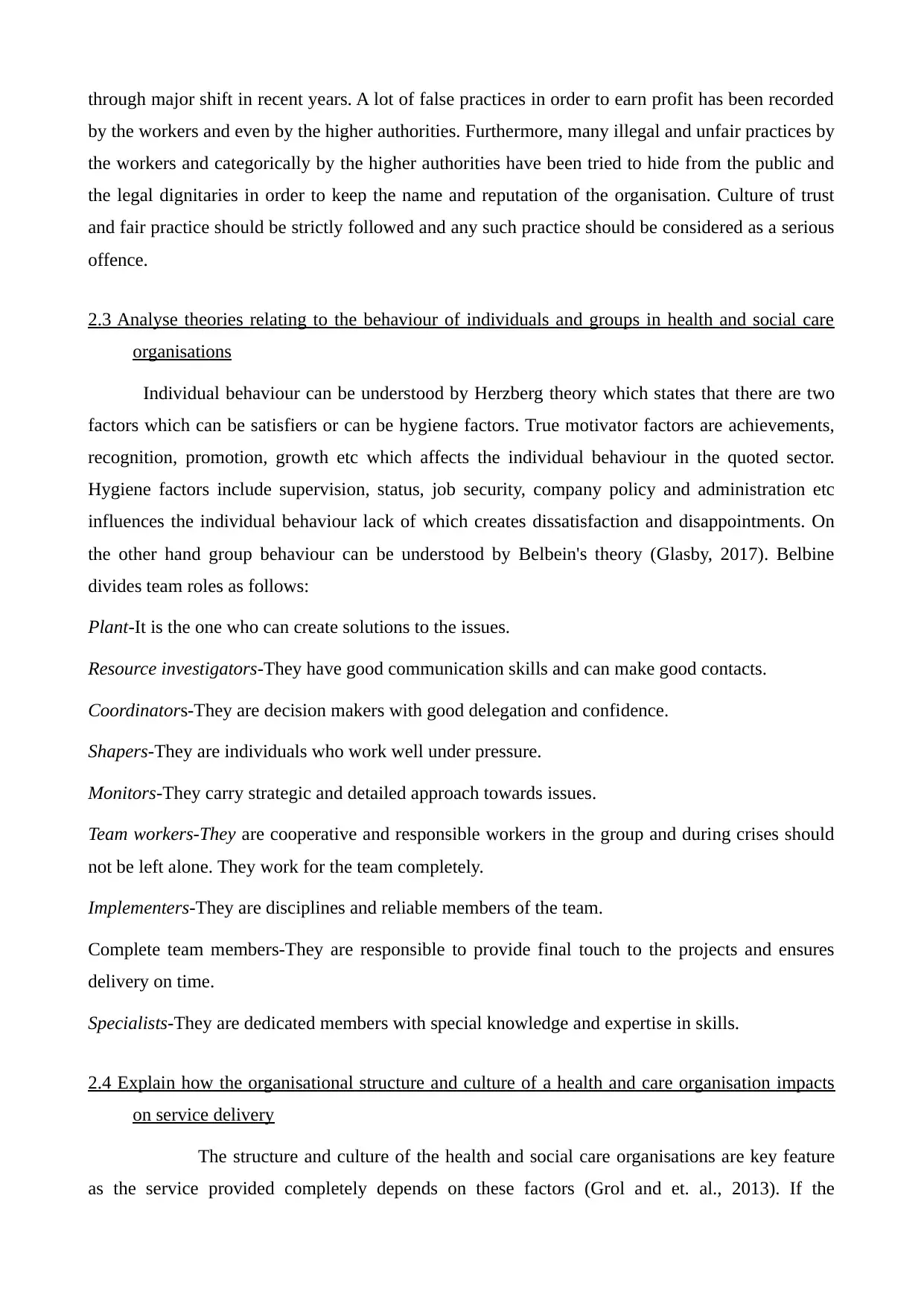
through major shift in recent years. A lot of false practices in order to earn profit has been recorded
by the workers and even by the higher authorities. Furthermore, many illegal and unfair practices by
the workers and categorically by the higher authorities have been tried to hide from the public and
the legal dignitaries in order to keep the name and reputation of the organisation. Culture of trust
and fair practice should be strictly followed and any such practice should be considered as a serious
offence.
2.3 Analyse theories relating to the behaviour of individuals and groups in health and social care
organisations
Individual behaviour can be understood by Herzberg theory which states that there are two
factors which can be satisfiers or can be hygiene factors. True motivator factors are achievements,
recognition, promotion, growth etc which affects the individual behaviour in the quoted sector.
Hygiene factors include supervision, status, job security, company policy and administration etc
influences the individual behaviour lack of which creates dissatisfaction and disappointments. On
the other hand group behaviour can be understood by Belbein's theory (Glasby, 2017). Belbine
divides team roles as follows:
Plant-It is the one who can create solutions to the issues.
Resource investigators-They have good communication skills and can make good contacts.
Coordinators-They are decision makers with good delegation and confidence.
Shapers-They are individuals who work well under pressure.
Monitors-They carry strategic and detailed approach towards issues.
Team workers-They are cooperative and responsible workers in the group and during crises should
not be left alone. They work for the team completely.
Implementers-They are disciplines and reliable members of the team.
Complete team members-They are responsible to provide final touch to the projects and ensures
delivery on time.
Specialists-They are dedicated members with special knowledge and expertise in skills.
2.4 Explain how the organisational structure and culture of a health and care organisation impacts
on service delivery
The structure and culture of the health and social care organisations are key feature
as the service provided completely depends on these factors (Grol and et. al., 2013). If the
by the workers and even by the higher authorities. Furthermore, many illegal and unfair practices by
the workers and categorically by the higher authorities have been tried to hide from the public and
the legal dignitaries in order to keep the name and reputation of the organisation. Culture of trust
and fair practice should be strictly followed and any such practice should be considered as a serious
offence.
2.3 Analyse theories relating to the behaviour of individuals and groups in health and social care
organisations
Individual behaviour can be understood by Herzberg theory which states that there are two
factors which can be satisfiers or can be hygiene factors. True motivator factors are achievements,
recognition, promotion, growth etc which affects the individual behaviour in the quoted sector.
Hygiene factors include supervision, status, job security, company policy and administration etc
influences the individual behaviour lack of which creates dissatisfaction and disappointments. On
the other hand group behaviour can be understood by Belbein's theory (Glasby, 2017). Belbine
divides team roles as follows:
Plant-It is the one who can create solutions to the issues.
Resource investigators-They have good communication skills and can make good contacts.
Coordinators-They are decision makers with good delegation and confidence.
Shapers-They are individuals who work well under pressure.
Monitors-They carry strategic and detailed approach towards issues.
Team workers-They are cooperative and responsible workers in the group and during crises should
not be left alone. They work for the team completely.
Implementers-They are disciplines and reliable members of the team.
Complete team members-They are responsible to provide final touch to the projects and ensures
delivery on time.
Specialists-They are dedicated members with special knowledge and expertise in skills.
2.4 Explain how the organisational structure and culture of a health and care organisation impacts
on service delivery
The structure and culture of the health and social care organisations are key feature
as the service provided completely depends on these factors (Grol and et. al., 2013). If the
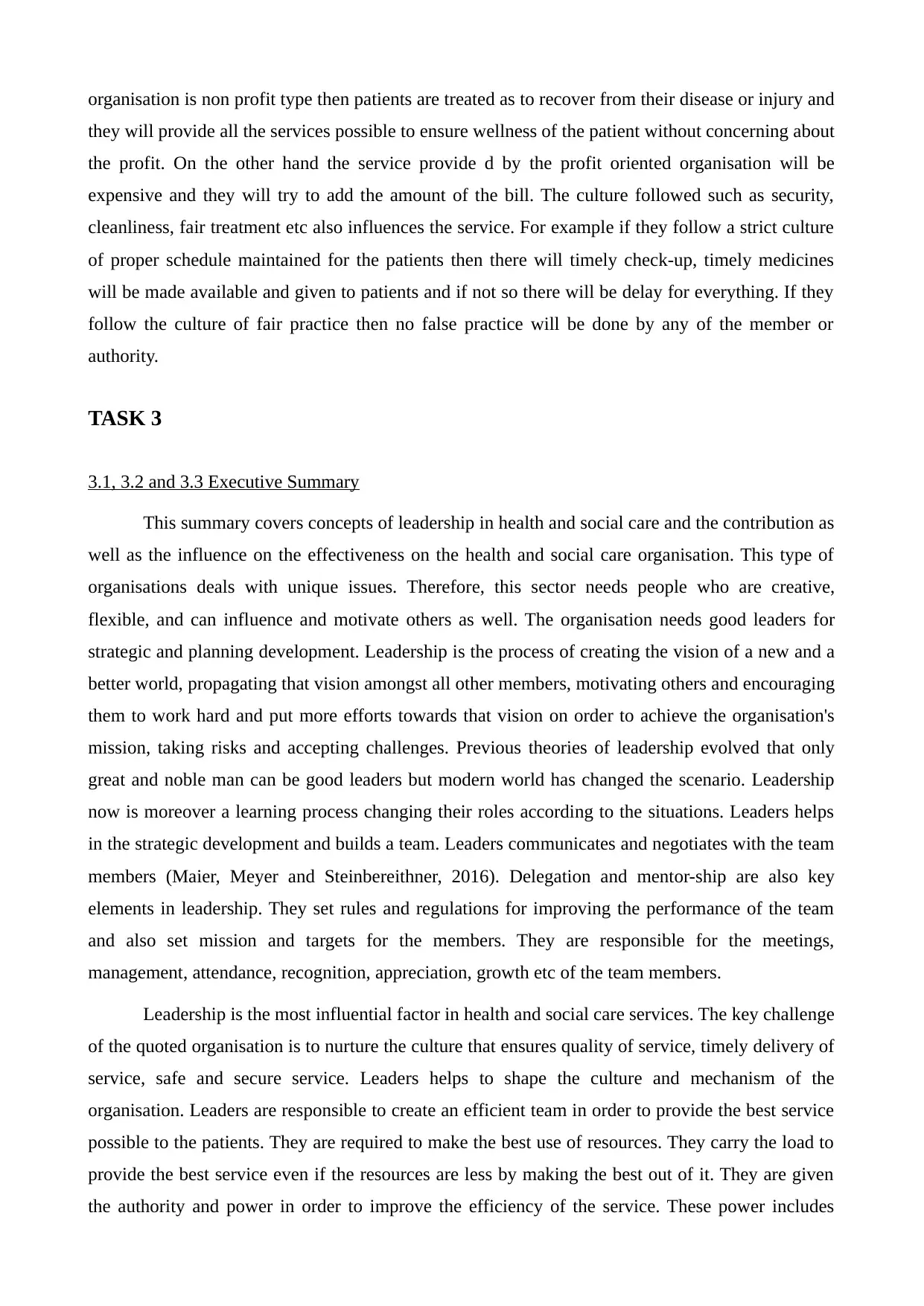
organisation is non profit type then patients are treated as to recover from their disease or injury and
they will provide all the services possible to ensure wellness of the patient without concerning about
the profit. On the other hand the service provide d by the profit oriented organisation will be
expensive and they will try to add the amount of the bill. The culture followed such as security,
cleanliness, fair treatment etc also influences the service. For example if they follow a strict culture
of proper schedule maintained for the patients then there will timely check-up, timely medicines
will be made available and given to patients and if not so there will be delay for everything. If they
follow the culture of fair practice then no false practice will be done by any of the member or
authority.
TASK 3
3.1, 3.2 and 3.3 Executive Summary
This summary covers concepts of leadership in health and social care and the contribution as
well as the influence on the effectiveness on the health and social care organisation. This type of
organisations deals with unique issues. Therefore, this sector needs people who are creative,
flexible, and can influence and motivate others as well. The organisation needs good leaders for
strategic and planning development. Leadership is the process of creating the vision of a new and a
better world, propagating that vision amongst all other members, motivating others and encouraging
them to work hard and put more efforts towards that vision on order to achieve the organisation's
mission, taking risks and accepting challenges. Previous theories of leadership evolved that only
great and noble man can be good leaders but modern world has changed the scenario. Leadership
now is moreover a learning process changing their roles according to the situations. Leaders helps
in the strategic development and builds a team. Leaders communicates and negotiates with the team
members (Maier, Meyer and Steinbereithner, 2016). Delegation and mentor-ship are also key
elements in leadership. They set rules and regulations for improving the performance of the team
and also set mission and targets for the members. They are responsible for the meetings,
management, attendance, recognition, appreciation, growth etc of the team members.
Leadership is the most influential factor in health and social care services. The key challenge
of the quoted organisation is to nurture the culture that ensures quality of service, timely delivery of
service, safe and secure service. Leaders helps to shape the culture and mechanism of the
organisation. Leaders are responsible to create an efficient team in order to provide the best service
possible to the patients. They are required to make the best use of resources. They carry the load to
provide the best service even if the resources are less by making the best out of it. They are given
the authority and power in order to improve the efficiency of the service. These power includes
they will provide all the services possible to ensure wellness of the patient without concerning about
the profit. On the other hand the service provide d by the profit oriented organisation will be
expensive and they will try to add the amount of the bill. The culture followed such as security,
cleanliness, fair treatment etc also influences the service. For example if they follow a strict culture
of proper schedule maintained for the patients then there will timely check-up, timely medicines
will be made available and given to patients and if not so there will be delay for everything. If they
follow the culture of fair practice then no false practice will be done by any of the member or
authority.
TASK 3
3.1, 3.2 and 3.3 Executive Summary
This summary covers concepts of leadership in health and social care and the contribution as
well as the influence on the effectiveness on the health and social care organisation. This type of
organisations deals with unique issues. Therefore, this sector needs people who are creative,
flexible, and can influence and motivate others as well. The organisation needs good leaders for
strategic and planning development. Leadership is the process of creating the vision of a new and a
better world, propagating that vision amongst all other members, motivating others and encouraging
them to work hard and put more efforts towards that vision on order to achieve the organisation's
mission, taking risks and accepting challenges. Previous theories of leadership evolved that only
great and noble man can be good leaders but modern world has changed the scenario. Leadership
now is moreover a learning process changing their roles according to the situations. Leaders helps
in the strategic development and builds a team. Leaders communicates and negotiates with the team
members (Maier, Meyer and Steinbereithner, 2016). Delegation and mentor-ship are also key
elements in leadership. They set rules and regulations for improving the performance of the team
and also set mission and targets for the members. They are responsible for the meetings,
management, attendance, recognition, appreciation, growth etc of the team members.
Leadership is the most influential factor in health and social care services. The key challenge
of the quoted organisation is to nurture the culture that ensures quality of service, timely delivery of
service, safe and secure service. Leaders helps to shape the culture and mechanism of the
organisation. Leaders are responsible to create an efficient team in order to provide the best service
possible to the patients. They are required to make the best use of resources. They carry the load to
provide the best service even if the resources are less by making the best out of it. They are given
the authority and power in order to improve the efficiency of the service. These power includes
⊘ This is a preview!⊘
Do you want full access?
Subscribe today to unlock all pages.

Trusted by 1+ million students worldwide
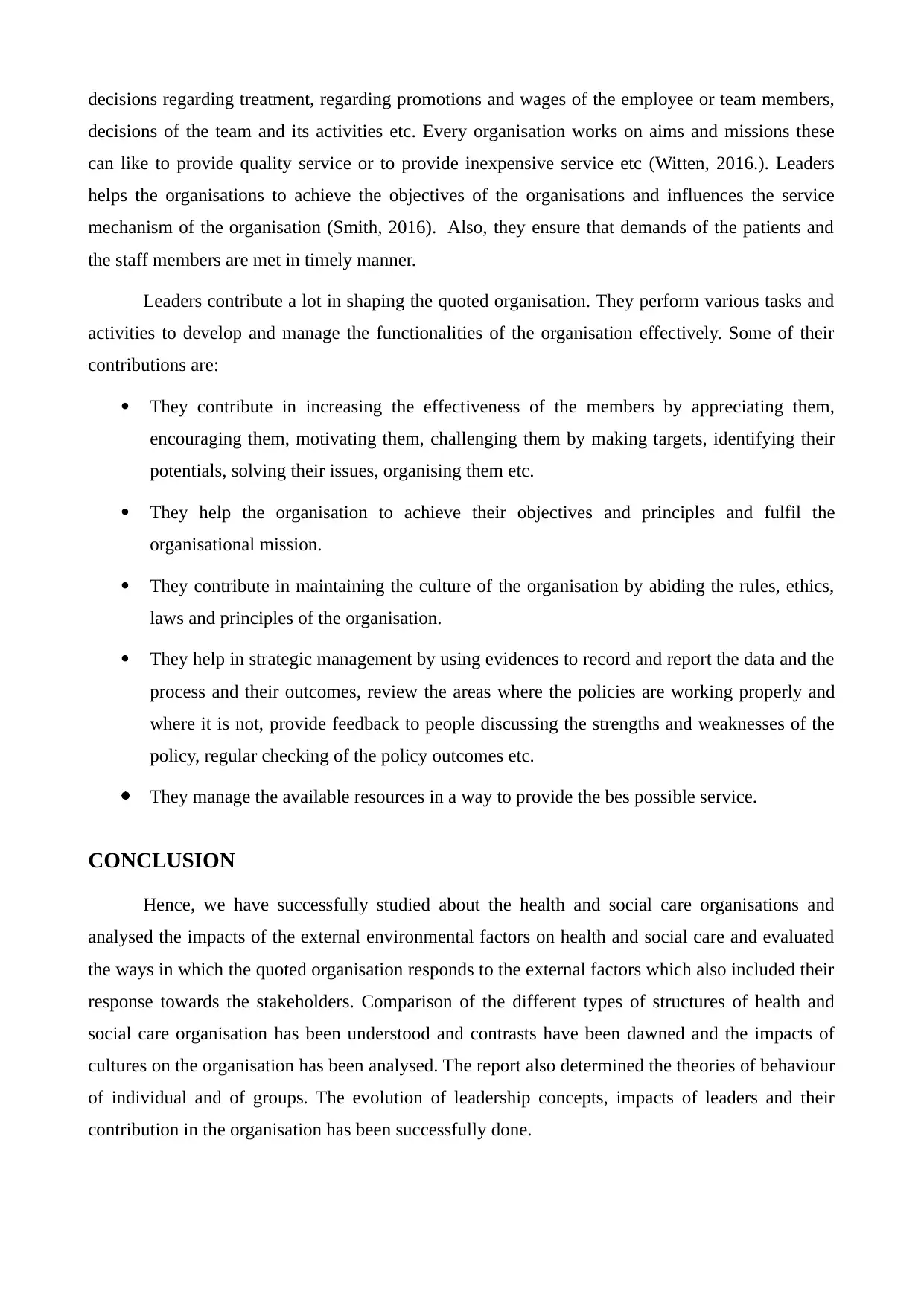
decisions regarding treatment, regarding promotions and wages of the employee or team members,
decisions of the team and its activities etc. Every organisation works on aims and missions these
can like to provide quality service or to provide inexpensive service etc (Witten, 2016.). Leaders
helps the organisations to achieve the objectives of the organisations and influences the service
mechanism of the organisation (Smith, 2016). Also, they ensure that demands of the patients and
the staff members are met in timely manner.
Leaders contribute a lot in shaping the quoted organisation. They perform various tasks and
activities to develop and manage the functionalities of the organisation effectively. Some of their
contributions are:
They contribute in increasing the effectiveness of the members by appreciating them,
encouraging them, motivating them, challenging them by making targets, identifying their
potentials, solving their issues, organising them etc.
They help the organisation to achieve their objectives and principles and fulfil the
organisational mission.
They contribute in maintaining the culture of the organisation by abiding the rules, ethics,
laws and principles of the organisation.
They help in strategic management by using evidences to record and report the data and the
process and their outcomes, review the areas where the policies are working properly and
where it is not, provide feedback to people discussing the strengths and weaknesses of the
policy, regular checking of the policy outcomes etc.
They manage the available resources in a way to provide the bes possible service.
CONCLUSION
Hence, we have successfully studied about the health and social care organisations and
analysed the impacts of the external environmental factors on health and social care and evaluated
the ways in which the quoted organisation responds to the external factors which also included their
response towards the stakeholders. Comparison of the different types of structures of health and
social care organisation has been understood and contrasts have been dawned and the impacts of
cultures on the organisation has been analysed. The report also determined the theories of behaviour
of individual and of groups. The evolution of leadership concepts, impacts of leaders and their
contribution in the organisation has been successfully done.
decisions of the team and its activities etc. Every organisation works on aims and missions these
can like to provide quality service or to provide inexpensive service etc (Witten, 2016.). Leaders
helps the organisations to achieve the objectives of the organisations and influences the service
mechanism of the organisation (Smith, 2016). Also, they ensure that demands of the patients and
the staff members are met in timely manner.
Leaders contribute a lot in shaping the quoted organisation. They perform various tasks and
activities to develop and manage the functionalities of the organisation effectively. Some of their
contributions are:
They contribute in increasing the effectiveness of the members by appreciating them,
encouraging them, motivating them, challenging them by making targets, identifying their
potentials, solving their issues, organising them etc.
They help the organisation to achieve their objectives and principles and fulfil the
organisational mission.
They contribute in maintaining the culture of the organisation by abiding the rules, ethics,
laws and principles of the organisation.
They help in strategic management by using evidences to record and report the data and the
process and their outcomes, review the areas where the policies are working properly and
where it is not, provide feedback to people discussing the strengths and weaknesses of the
policy, regular checking of the policy outcomes etc.
They manage the available resources in a way to provide the bes possible service.
CONCLUSION
Hence, we have successfully studied about the health and social care organisations and
analysed the impacts of the external environmental factors on health and social care and evaluated
the ways in which the quoted organisation responds to the external factors which also included their
response towards the stakeholders. Comparison of the different types of structures of health and
social care organisation has been understood and contrasts have been dawned and the impacts of
cultures on the organisation has been analysed. The report also determined the theories of behaviour
of individual and of groups. The evolution of leadership concepts, impacts of leaders and their
contribution in the organisation has been successfully done.
Paraphrase This Document
Need a fresh take? Get an instant paraphrase of this document with our AI Paraphraser
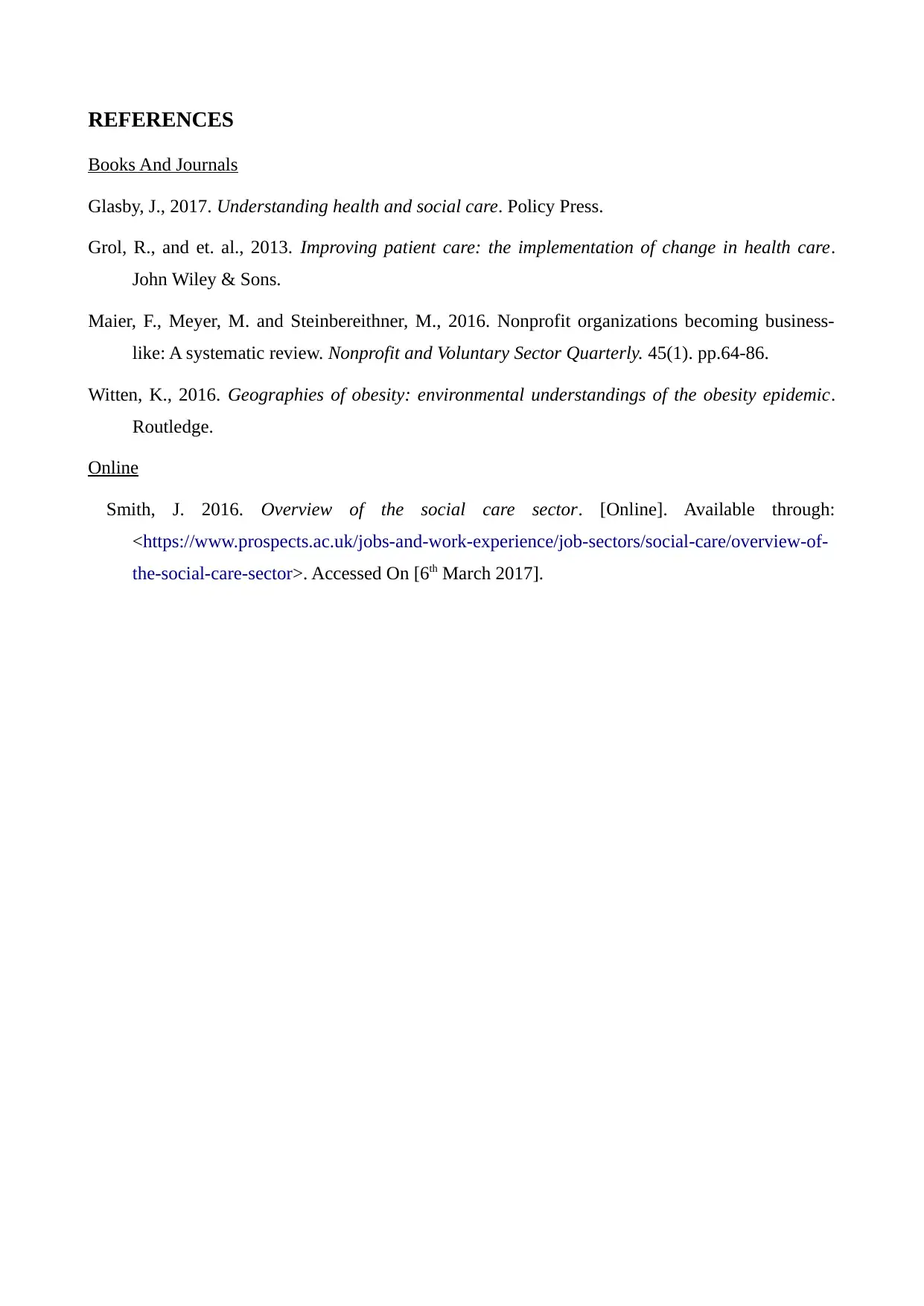
REFERENCES
Books And Journals
Glasby, J., 2017. Understanding health and social care. Policy Press.
Grol, R., and et. al., 2013. Improving patient care: the implementation of change in health care.
John Wiley & Sons.
Maier, F., Meyer, M. and Steinbereithner, M., 2016. Nonprofit organizations becoming business-
like: A systematic review. Nonprofit and Voluntary Sector Quarterly. 45(1). pp.64-86.
Witten, K., 2016. Geographies of obesity: environmental understandings of the obesity epidemic.
Routledge.
Online
Smith, J. 2016. Overview of the social care sector. [Online]. Available through:
<https://www.prospects.ac.uk/jobs-and-work-experience/job-sectors/social-care/overview-of-
the-social-care-sector>. Accessed On [6th March 2017].
Books And Journals
Glasby, J., 2017. Understanding health and social care. Policy Press.
Grol, R., and et. al., 2013. Improving patient care: the implementation of change in health care.
John Wiley & Sons.
Maier, F., Meyer, M. and Steinbereithner, M., 2016. Nonprofit organizations becoming business-
like: A systematic review. Nonprofit and Voluntary Sector Quarterly. 45(1). pp.64-86.
Witten, K., 2016. Geographies of obesity: environmental understandings of the obesity epidemic.
Routledge.
Online
Smith, J. 2016. Overview of the social care sector. [Online]. Available through:
<https://www.prospects.ac.uk/jobs-and-work-experience/job-sectors/social-care/overview-of-
the-social-care-sector>. Accessed On [6th March 2017].
1 out of 8
Related Documents
Your All-in-One AI-Powered Toolkit for Academic Success.
+13062052269
info@desklib.com
Available 24*7 on WhatsApp / Email
![[object Object]](/_next/static/media/star-bottom.7253800d.svg)
Unlock your academic potential
Copyright © 2020–2025 A2Z Services. All Rights Reserved. Developed and managed by ZUCOL.





